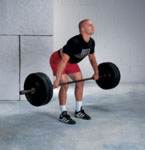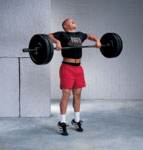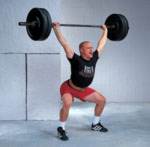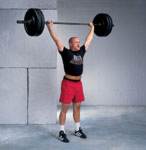New BFS Total Program Concept Auxiliary LiftsTWO NEW CHOICES: STANDARD AND ADVANCEDBy Dr. Greg Shepard Published: Summer 2003 The BFS Program has evolved over the years and now offers coaches and athletes two choices when selecting auxiliary exercises to complement the core lifts. These two choices for auxiliaries are standard and advanced. In doing our BFS Clinics we found a wide variety among participants’ training experience, sophistication, knowledge, available equipment, and even district and school policies. Therefore, we thought we could best serve coaches and athletes by providing a choice of two types of auxiliary lifts. BFS Strategies for Both Choices Auxiliary lifts are practiced in addition to the BFS core lifts. Less emphasis is placed on auxiliaries. Core lifts are plugged into the one-per-month-cycle BFS Set-Rep Rotation System, auxiliary lifts are normally done by doing two sets of 10 reps, and advanced quick lifts use two sets of five reps. If an athlete is training with a small group, the auxiliaries are performed after the core lifts. Otherwise, coaches would have their athletes alternate between core lifts and auxiliaries: one-third would do core lift one, one-third would do core lift two, and one-third would do auxiliaries. If using a multi-station core lift approach, some auxiliaries could even be performed without rotating. Select no more than five auxiliary lifts. When you start doing more than that, especially ten or more, then you’ll find that your athletes will not have enough time and energy to do sprinting, stamina, flexibility, plyometric, agility and technique work. Think of the “total package.” You must not overemphasize one area of training at the expense of another area. Remember, the ultimate objective is for your athletes to reach their potential as athletes and win. Therefore, select only those exercises that will really contribute to your ultimate objective. Select auxiliary lifts for your program by considering which ones will help you win and which ones will help prevent a specific injury. For example, on a scale of one to ten, how important are neck exercises to a football player or a wrestler? Obviously they are very important. However, to a basketball player, neck exercises are not that important—so you select an auxiliary that is important for that sport. BFS Advanced Auxiliary Lifts The Advanced Auxiliary Lifts are harder to perform than the BFS Standard Auxiliaries and require better coaching and organization. Any overhead lift is considered an advanced lift. Caution should be used before giving the green light for larger groups of students/athletes. Only after learning basic lifting techniques such as the Six Absolutes will athletes benefit from these exercises. These lifts include the power snatch, jerk press, push press and the balance drills. The equipment I recommend for these advanced lifts is as follows: dowels for learning technique safely, training plates and light bumper plates, and an Aluma-lite and/or Ultra-Lite Barbell. Also, a power rack with a high spotting tier is recommended when doing the jerk press or push press. To further learn and teach the technique of these lifts, I highly recommend our Total Program video/DVD. |
 |
|
Step 1: Lift the bar from the floor in a controlled movement, and when the bar is just above the knees, jump as high and as explosively as possible. Notice the wide grip. Keep the knuckles pointed towards the floor. |
 |
|
Step 2: Jump straight up, rise up on toes, keep eyes on target, knuckles to the floor and elbows to the ceiling. |
 |
|
Step 3: Now pop under the bar and rack it overhead as shown. The feet should pop out to the athletic stance (wider than the jump stance). Keep using the Six Absolutes. Balance. |
 |
|
Step 4: The finish. Stand up and bring the feet back to the jump stance. |